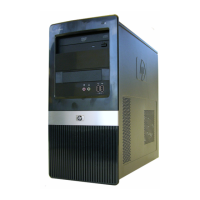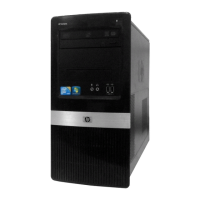Poor performance is experienced.
Cause
Solution
Processor is hot. 1. Make sure airflow to the computer is not
blocked. Leave a 10.2-cm (4-inch) clearance
on all vented sides of the computer and above
the monitor to permit the required airflow.
2. Make sure fans are connected and working
properly (some fans only operate when
needed).
3. Make sure the processor heatsink is installed
properly.
Hard drive is full. Transfer data from the hard drive to create more
space on the hard drive.
Low on memory. Add more memory.
Hard drive fragmented. Defragment hard drive.
Program previously accessed did not release
reserved memory back to the system.
Restart the computer.
Virus resident on the hard drive. Run virus protection program.
Too many applications running. 1. Close unnecessary applications to free up
memory. Some applications run in the
background and can be closed by right-
clicking on their corresponding icons in the
task tray. To prevent these applications from
launching at startup, go to Start > Run
(Microsoft Windows XP) or Start > All
Programs > Accessories > Run (Microsoft
Windows Vista) and type msconfig. On the
Startup tab of the System Configuration
Utility, uncheck applications that you do not
want to launch automatically.
CAUTION: Do not prevent applications
from launching at startup that are required for
proper system operation.
2. Add more memory.
Some software applications, especially games, are
stressful on the graphics subsystem
1. Lower the display resolution for the current
application or consult the documentation that
came with the application for suggestions on
how to improve performance by adjusting
parameters in the application.
2. Add more memory.
3. Upgrade the graphics solution.
Cause unknown. Restart the computer.
Table 1 Solving General Problems (continued)
ENWW
Basic Troubleshooting
11

